Kamal A.A. 1000 Solved Problems in Classical Physics: An Exercise Book
Подождите немного. Документ загружается.

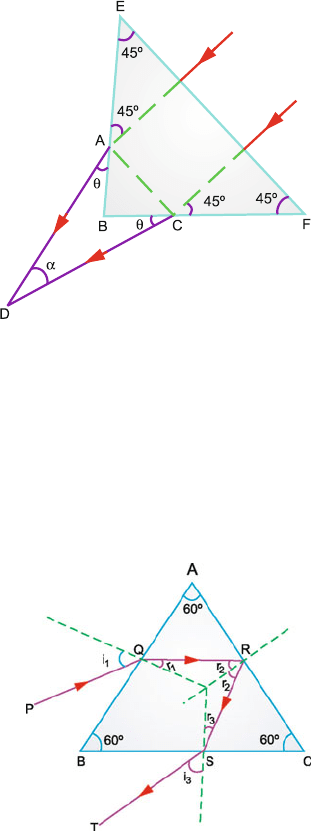
730 15 Optics
Fig. 15.17 Refractionina
prism
15.8 The net deviation of the ray
δ = (i
1
−r
1
) + (360
◦
− 2r
2
) + (i
3
−r
3
) (1)
In the minimum angle position, r
1
= r
2
= A/2 = 60/2 = 30
◦
From the geometry of Fig. 15.18, r
3
= 30
◦
.
Fig. 15.18 Deviation of a ray
incident in the minimum
deviation position of the
prism after suffering one
internal reflection
By Snell’s law
Sin i
1
= n sin r
1
= 1.5 ×sin 30
◦
= 0.75
∴ i
1
= 48.59
◦
Similarly, i
3
= 48.59
◦
∴ δ = (48.59 − 30
◦
) + (360 − 2 × 30
◦
) + (48.59 − 30
◦
) = 337.18
◦
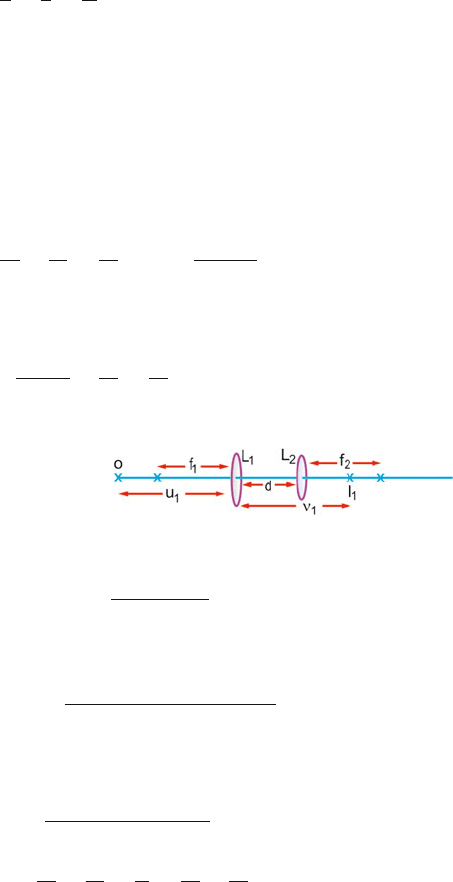
15.3 Solutions 731
15.9
1
u
+
1
v
=
1
f
where u, the object distance, and v, the image distance, are measured from the
centre of the lens. For real object and image u and v are positive, for virtual
object or image u and v are negative. f is positive for convex lens and negative
for concave lens.
Let the object o be placed at distance u
1
from lens L
1
of focal length f
1
.The
second tens L
2
is placed at distance d behind L
1
,Fig.15.19. The image I
1
is
formed at distance v
1
from the lens L
1
, alone. Then from the lens equation
1
u
1
+
1
ν
1
=
1
f
1
or ν
1
=
f
1
u
1
u
1
− f
1
(1)
The image acts as an object for the second lens L
2
(real or virtual)
−
1
v
1
− d
+
1
v
2
=
1
f
2
Fig. 15.19 Image due to combination of two lenses, a distance d apart
whence v
2
=
f
2
(v
1
− d)
f
2
+ v
1
− d
Substituting ν
1
from (1) and simplifying
v
2
= f
2
[ f
1
u
1
− d(u
1
− f
1
)]
f
1
u
1
+ (u
1
− f
1
)( f
2
− d)
(2)
In the limit d → 0, (2) reduces to
v
2
=
f
1
f
2
u
1
f
1
u
1
+ f
2
u
1
− f
1
f
2
or
1
u
1
+
1
v
2
=
1
f
=
1
f
1
+
1
f
2
15.10 The location of the object, the screen and the positions of the lens are indi-
cated in Fig. 15.20
(a)
u
1
+ v
1
= D (1)
u
1
− u
2
= d (2)
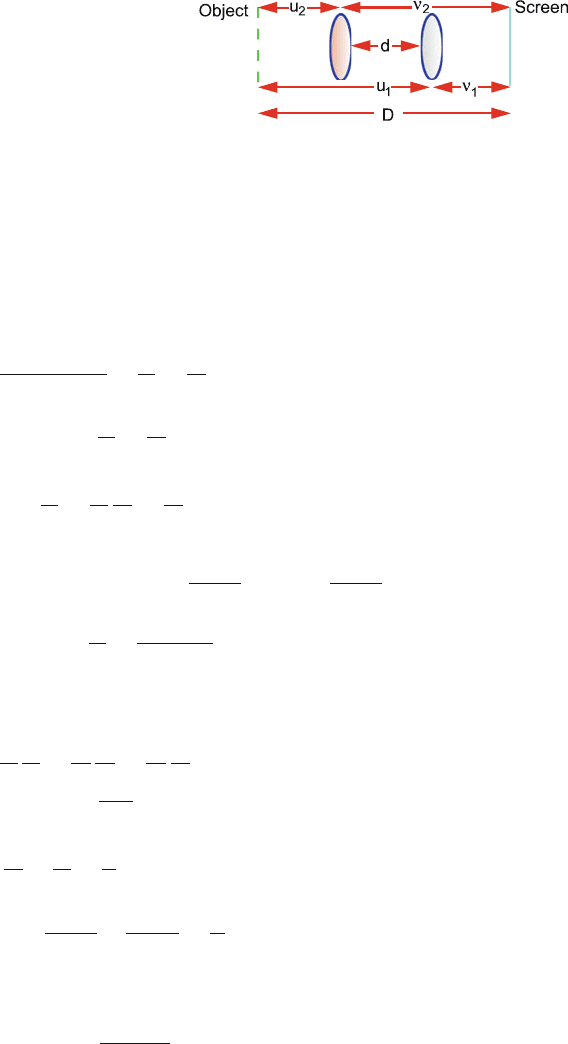
732 15 Optics
Fig. 15.20 Real images
formed by a convex lens in
two positions
By symmetry v
2
= u
1
(3)
v
1
= u
2
(4)
Then (2) becomes
u
1
− v
1
= d (5)
size of image
size of object
=
I
1
O
=
v
1
u
1
(6)
Similarly,
I
2
O
=
v
2
u
2
(7)
∴
I
1
I
2
=
v
1
v
2
u
2
u
1
=
v
2
1
v
2
2
(8)
From (1) and (5), v
2
=
D + d
2
and v
1
=
D − d
2
Therefore,
I
1
I
2
=
(D − d)
2
(D + d)
2
(b) Multiplying (6) and (7)
I
1
O
I
2
O
=
v
1
u
1
v
2
u
2
=
u
2
u
1
u
1
u
2
= 1
∴ O =
I
1
I
2
(c)
1
u
1
+
1
v
1
=
1
f
∴
2
D + d
+
2
D − d
=
1
f
where we have used (1), (2) and (4).
∴ f =
D
2
− d
2
4D
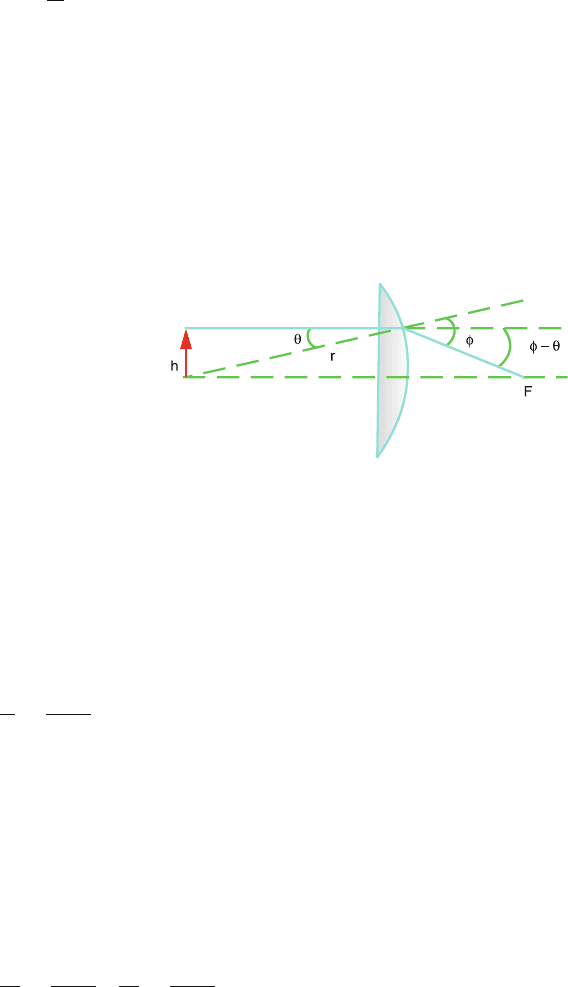
15.3 Solutions 733
(d) From the result of (c),wehave
d
2
=
D
f
(D − 4 f )
Since d
2
must be positive, it follows that D > 4 f .
15.11
(a) Consider a plano-convex lens of focal length f . Let a paraxial ray be
incident on the lens from a small object of height h. After striking the
plano-convex lens normally, it gets refracted at the convex surface and
passes through the principle focus F, behind the lens, Fig. 15.21.Letθ
be the angle of incidence at A, the angle being measured with the radius
of curvature of the curved surface r.Letφ be the angle of refraction:
Fig. 15.21
A
sin φ = n sin θ(Snell’s law)
φ = nθ(∵ angles are small) (1)
Also θ = h/r,φ− θ = h/ f (2)
Combining (1) and (2)
1
f
=
n − 1
r
(3)
We use the convention that r is positive if the refracting surface facing
the object is convex and r is negative if the refracting index facing the
object is concave.
A thin lens may be considered as two plano-convex or two plano-
concave lenses in contact. Thus a thin biconvex lens whose faces have
radii of curvature r
1
and r
2
are considered as two plano-convex lenses
with their plane surfaces cemented together:
1
f
1
=
n − 1
r
1
,
1
f
2
=
n − 1
−r
2
(4)
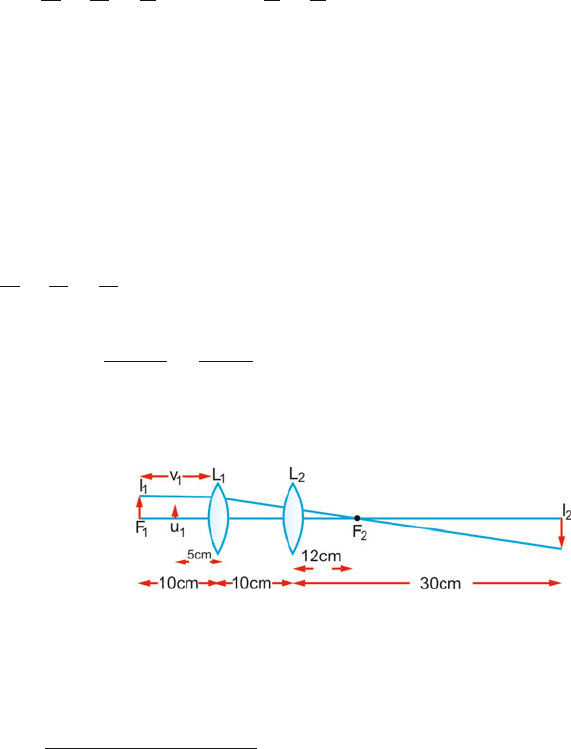
734 15 Optics
∴
1
f
1
+
1
f
2
=
1
F
= (n − 1)
1
r
1
−
1
r
2
(lens maker’s formula)
(5)
For a biconvex lens r
1
is positive and r
2
negative. For double-concave
lens r
1
is negative and r
2
positive.
(b) If the lens of refractive index n
1
is immersed in a medium of index
n
2
, then n = n
1
/n
2
, n = 1.2/1.33 = 0.9, and the first bracket in (5)
becomes n − 1 =−0.1 resulting in a negative value of F. Thus the
plastic lens immersed in water acts as a diverging lens.
15.12
(a) The first image due to L
1
alone is formed at I
1
at a distance v
1
given by
1
u
1
+
1
v
1
=
1
f
1
∴ v
1
=
u
1
f
1
u
1
− f
1
=
5 × 10
5 − 10
=−10 cm
The image is formed at 10 cm in front of the lens (Fig. 15.22).
Fig. 15.22 Image due to
combination of two convex
lenses
(b) The image is virtual (∵ v is negative) and erect.
(c) The final image I
2
is located at distance ν
2
from lens L
2
given by the
result of prob. (15.9),
v
2
=
f
2
[ f
1
u
1
− d(u
1
− f
1
)]
f
1
u
1
+ (u
1
− f
1
)( f
2
− d)
(1)
Here u
1
= 5cm,d = 10 cm, f
1
= 10 and f
2
= 12 cm.
Substituting these values in (1) we find v
2
= 30 cm behind the lens L
2
.
(d) The final image is real (∵ v
2
is positive) and inverted.
15.13 Let a ray PA enter the sphere at A, refract at A and B and intersect the axis at
F (Fig. 15.23). Let φ be the angle of incidence and θ the angle of refraction
at A:
Sin φ = μ sin θ (Snell’s law) (1)
φ = μθ (∵ angles are small) (2)
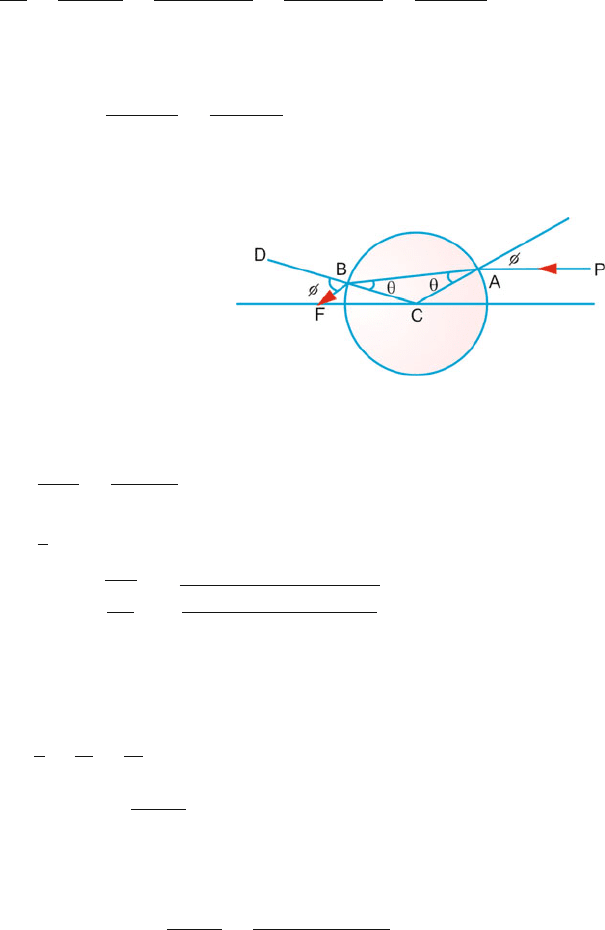
15.3 Solutions 735
In BFC,
FC
BC
=
sin F
ˆ
BC
sin B
ˆ
FC
=
sin(π −φ)
sin 2(φ − θ)
=
sin φ
sin 2(φ − θ)
=
φ
2(φ − θ)
(3)
since the angles are small. Hence the equivalent focal length
F
eq
= FC =
BCφ
2(φ − θ)
=
μr
2(μ − 1)
(4)
where we have used (2), (3) and (4).
Fig. 15.23
15.14 The intensity at a distance r is given by
I =
W
4πr
2
=
100
4π ×5
2
= 0.318 W/m
2
I =
1
2
ε
0
cE
2
0
∴ E
0
=
2 I
ε
0
c
=
2 × 0.318
8.85 × 10
−12
× 3 × 10
8
= 15.48 V/m
15.15
(a) If the object distance is u then the distance v
1
at which the image is
formed by objective is given by
1
u
+
1
v
1
=
1
f
o
or v
1
=−
uf
o
u − f
o
(1)
The distance of this image from the eyepiece, u
1
is given by
u
1
= f
o
+ f
e
−
uf
o
u − f
o
=
uf
e
− f
2
o
− f
o
f
e
u − f
o
(2)
where f
o
+ f
e
is the distance between the objective and eyepiece.

736 15 Optics
If the final image is formed at a distance v from the eyepiece then
1
v
+
1
u
1
=
1
f
e
or
1
v
=
1
f
e
−
u − f
o
uf
e
− f
2
e
− f
o
f
e
or v =−
f
e
(uf
e
− f
2
o
− f
o
f
e
)
f
2
o
(3)
Now u >> f
e
, f
o
∴ v =−u
f
e
f
o
2
= 10
4
1
8
2
= 156.25 m
(b)
M =
Height of the final image
Height of the object
=
v
1
u
×
v
u
1
−
f
e
f
o
=−
1
8
=−0.125
where we have used (1), (2) and (3).
∴ Height of final image = (height of the object).M
=−100 × 0.125 =−12.5m
The negative sign indicates that the final image is virtual.
Note that the height of the image is only one-eighth of that of the
object, but the image is closer than the object by a factor of 64, so it
subtends an angle eight times large, that is, the image appears eight times
larger.
15.16
(a) The Intensity is given by
I =
power
cross-section
=
W
A
=
1000
10
−5
× 10
−4
= 10
12
W/m
2
(b)
I =
1
2
ε
0
cE
2
0
E
0
=
2I
ε
0
c
=
2 × 10
12
8.85 × 10
−12
× 3 × 10
8
= 2.74 ×10
7
V/m
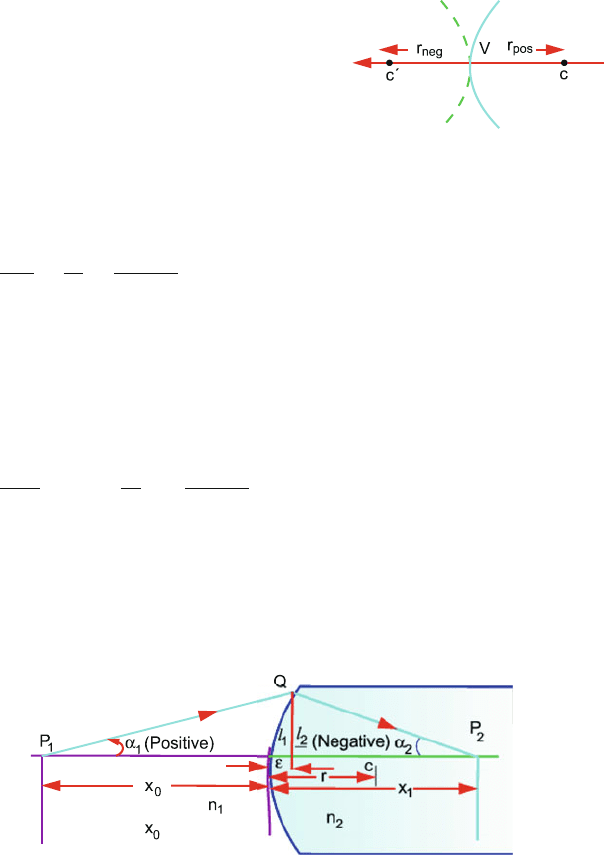
15.3 Solutions 737
15.3.3 Matrix Methods
15.17 Assume that light is always incident from the left, then the refracting surface
is convex if r is positive (from V to C) and concave if r is negative (from V
to C
), Fig. 15.24.
Fig. 15.24 Light is incident
from left. Sign convention for
refraction at a curved optical
surface
The symbols used are object distance x
0
, object size y
0
, image distance x
i
,
image size y
i
and radius of curvature, r. The object–image equation can be
written as
n
1
−x
0
+
n
2
x
i
=
n
2
− n
1
r
(1)
The convention r esults in negative value for the object distance. Paraxial rays
are considered so that α
1
and α
2
are small. Each ray is given a height and
an angle, Fig. 15.25. The distance ε on the axis, called sagitta, is nearly
zero. Considering counterclockwise angles as positive and clockwise angles
as negative (1) becomes
n
1
α
1
l
1
+ n
2
−
α
2
l
2
=
n
2
− n
1
r
(2)
As l
2
= l
1
, two simultaneous equations can be written in the variables α
j
and l
j
( j = 1, 2):
l
2
= l
1
(3)
Fig. 15.25 Passage of a light ray P
1
in medium of refractive index n
1
into medium of refractive
index n
2
onto P
2
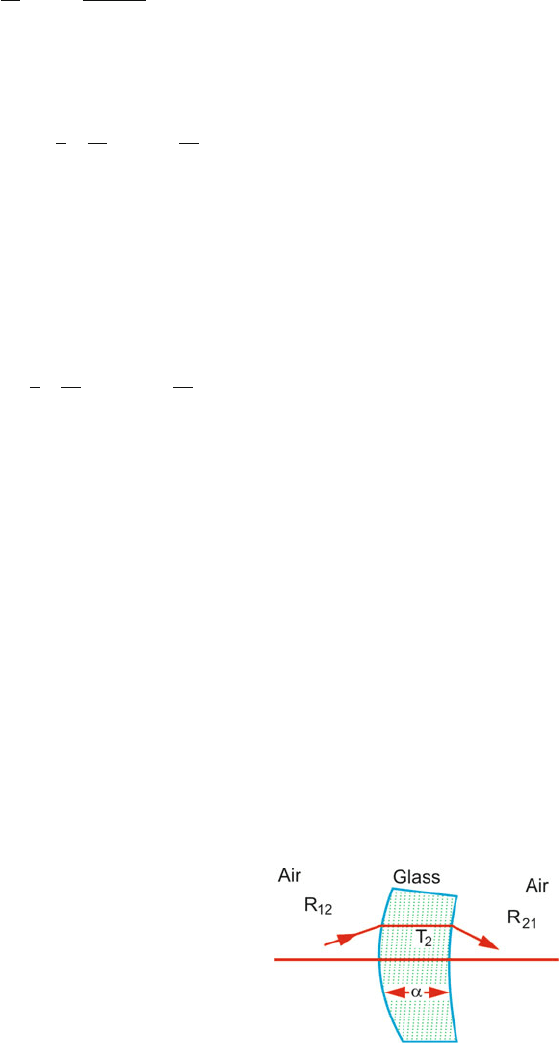
738 15 Optics
α
2
=
n
1
n
2
α
1
−
n
2
− n
1
n
2
r
l
1
(4)
In the matrix form (3) and (4) can be written as
l
2
α
2
=
⎛
⎝
10
1
r
n
1
n
2
− 1
n
1
n
2
⎞
⎠
l
1
α
1
(5)
The initial image in medium 1 described by the column vector I
1
=
l
1
α
1
is
transformed into the final image in medium 2 described by the column vector
I
2
=
l
2
α
2
. The transformation is accomplished by the refraction matrix
R
12
=
⎛
⎝
10
1
r
n
1
n
2
− 1
n
1
n
2
⎞
⎠
(6)
In the matrix notation (5) is written as
I
2
= R
12
I
1
(7)
Next consider a parallel translation of a ray through a distance d in some
homogeneous medium, Fig. 15.26.
Since α
1
= α
2
, for small angles
l
2
= l
1
+ α
1
d (8)
In matrix form (8) can be written as
l
2
α
2
=
1 d
01
l
1
α
1
(9)
or I
2
= T
2
I
1
(10)
Fig. 15.26 Sequences of
refraction, translation and
refraction for a thick lens
placed in air
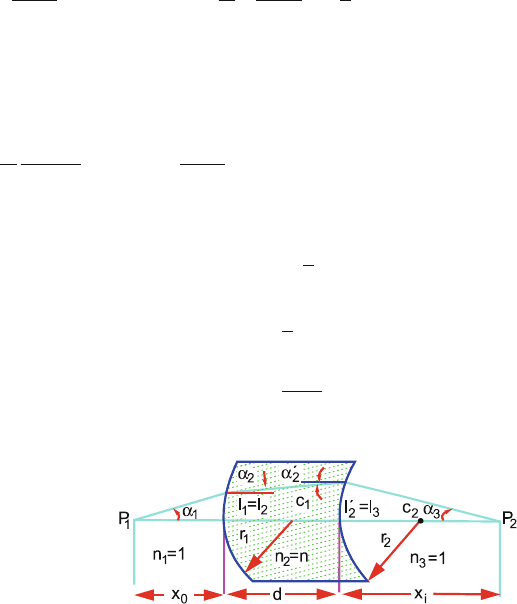
15.3 Solutions 739
where the translation matrix is
T
2
=
1 d
01
(11)
In Fig. 15.26, the overall transformation can be written as
I
2
= R
21
T
2
R
12
I
1
(12)
where R
12
is the refraction matrix at the first surface (air to glass), T
2
is the
translation matrix in the second medium (glass) and R
21
is the refraction
matrix at the second surface (glass to air). The matrix R
21
T
2
R
12
is known as
the system matrix.
15.18 Consider two curved surfaces of positive radii of curvature, r
1
and r
2
.The
final image in Fig. 15.27 is obtained from the equation:
l
3
α
3
=
⎛
⎝
10
n − 1
r
2
n
⎞
⎠
1
0
d
1
⎛
⎝
10
1
r
1
1 − n
n
1
n
⎞
⎠
l
1
α
1
Symbolically,
I
3
= R
23
T
2
R
12
I
1
Let P
12
=
1
r
1
(1 − n)
n
and P
23
=
n − 1
r
2
Then
l
3
α
3
=
10
P
23
n
1
0
d
1
10
P
12
1
n
l
1
α
1
=
⎛
⎜
⎜
⎝
1 + dP
12
d
n
P
23
+ dP
23
P
12
+ nP
12
dP
23
n
+ 1
⎞
⎟
⎟
⎠
l
1
α
1
Fig. 15.27 Refractionina
double convex lens of
thickness d placed in air
